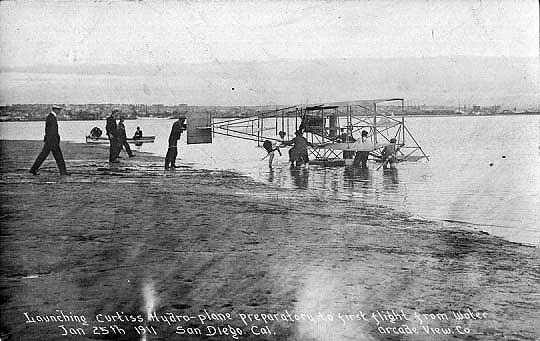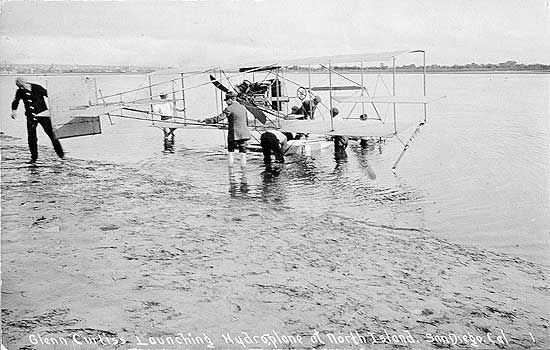

Glenn Hammond Curtiss will always remain one of the true pioneers in all of Aviation. He systematically earned himself the titles of the "Father of the American Aviation Industry" and the "Father of Naval Aviation": much of this was developed in California. It must be remembered that Curtiss was actually the first to manufacture and sell airplanes in the U.S.: which occurred in New York State and many of his important demonstrations happened very soon afterward in California. He was also awarded U.S. pilot's license no. 1 when the Wrights were awarded no.s 4 & 5 by the Aero Club of America! How did this happen? Simple: Curtiss was the first to go public; both in demonstrations of flight, and also with his improvements and enterprise.
In December of 1903, the month, if not the year of fate: aviation pioneer Prof. Samuel Pierpoint Langley witnessed his pilot, Charles Manley, crash his powered tandem wing "Aerodrome" into the Potomac River, just one week before the Wrights powered an aircraft at Kitty Hawk. It was later determined that Langley's aircraft ironically caught on the launching catapult, which kept the craft from being properly released, causing serious damage. Matters became even more controversial when, in 1914, aviation pioneer Glenn Curtiss was asked by the staff of the Smithsonian Institute, (Langley's former employer) to see if he could rebuild the late Prof. Langley's Aerodrome and make it fly. Wright apologists claim that Curtiss was the one who approached the Smithsonian, but this is erroneous according to documented history apart from Orville Wright's accusations.
By 1914, Glenn Curtiss's airplane business was being threatened by several law suits from the Wright Co., who claimed that a previously awarded "wing warping" patent covered all later inventions (which the Wright's ironically, had nothing to do with): such as Curtiss's ailerons and in fact, the airplane itself, which developed independently on both sides of the Atlantic! Contrary to the Wright's accusations, Glenn Curtiss was very careful to restore the Aerodrome to its original condition on the initial flight at Hammondsport, New York. Langley's restored Aerodrome not only flew on this experimental flight, but Curtiss even improved the airplane's horsepower on later experiments and proved it to be even more viable indeed. These latter "improvements" were used against Curtiss ever since then as being questionable: ignoring his first "unimproved" flight. These successful experiments led the Smithsonian to adopt the theory that Langley was potentially the first to make a powered aircraft. This allegation, of course, was hotly criticized and argued against by Orville Wright. Eventually, in 1942, the Smithsonian reversed its position on Langley and adopted Orville Wright's claim instead, in order to receive the original 1903 Wright Flyer into its collection in 1948, where it is today.
Another strong point of controversy lies in how much of the Wrights' flights and writings actually did influence aviation before 1908 when, by that time, aviation was active on both sides of the Atlantic. The Wrights' feats were not fully realized publicly until approximately 1906 and 1907! The Aero Club of America did not even acknowledge the many Wright flights in 1905 until March of 1906. Alberto Santos Dumont had already flown a powered airplane in Paris by 1906 of a completely different "box kite" design by Lawrence Hargrave. These Wright writings did not reach Europe until 1907 in the form of the French publication "Les Experiences des Freres Wright". In 1908, Wilber and Orville Wright finally publicly demonstrated their flyers in France and the U.S. Before then, the Wrights had been secretive about their flyers and their feats and declined to enter the public arena or air shows. Glenn Hammond Curtiss had won the World's first significant Aviation Meet in Reims, France in 1909 and set a world's speed record. Flight control by use of the "aileron", and more powerful aircraft engines had been developed before the time Wilber Wright even landed in France in 1908, making "wing warping", The Wright's claim to fame, obsolete.
Frenchman Robert Esnault-Pelterie is credited for the first use of the "aileron", which was also invented independently by Alexander Graham Bell, Glenn Curtiss and the A.E.A. in America. This new system was a vast improvement over the Wright's wing-warping technique of flight control, in that ailerons and the addition of Curtiss's "steering wheel" control system, have been used in aircraft ever since.

It all started with Alexander Graham Bell, (the famous inventor of the telephone) who founded the A.E.A. (Aerial Experiment Association) in 1907 and invited Glenn Hammond Curtiss to help his team build "a practical airplane" which would carry a man on its own power, (indicating an unawareness of the Wright's previous secluded experiments.) Curtiss was already known for developing probably the best light weight engines at the time, and was contracted by Capt. Thomas Baldwin, the famous balloonist from California. Curtiss built an engine for Capt. Baldwin's lighter-than-air craft: The "California Arrow" in 1906. Ironically, there was an unrelated Frederick Baldwin, who was an A.E.A. member as Chief Engineer. Lt. Thomas F. Selfridge (who was later to die as a passenger in a Wright airplane) was Secretary. An interesting side note: a Dr. William Whitney Christmas made a flight in a powered biplane of his own design on March 8, 1908 at Fairfax Courthouse, Virginia, but this was not "publicly" observed. The first recognized "publicly observed" demonstration of a powered heavier-than-air flyer in America is credited to Glenn Curtiss, who flew his "June Bug" on July 4, 1908 in front of a huge crowd and skeptical newspaper reporters from New York. (Frederick Baldwin actually flew A.E.A.'s "Red Wing" before this on March 12, 1908, but again, it was not in public).
By January 10, 1910, Glenn Curtiss had come to Los Angeles to star in America's first Air Meet: at Dominguez Field. He took major prizes and was celebrated just previous to this in the Rose Parade in Pasadena. This meet was almost cancelled by a Wright injunction, but a judge ordered in favor of the air meet as it was out of jurisdiction. In 1911, Glenn Curtiss came to San Francisco and San Diego to become the "Father of Naval Aviation". An aircraft carrier was built according to Curtiss specifications from an existing Navy ship in San Francisco harbor. On Jan. 18, 1911, Eugene Ely, successfully flew a Curtiss D-IV "Pusher" both off and onto the deck of the USS Pennsylvania. (Ely performed the first take off from an aircraft carrier in 1910 in the East, but did not execute the landing at the time). The Navy was not impressed and didn't see an immediate future for the aircraft carrier, but encouraged Curtiss to build a sea plane which could be used for reconnaissance on a battleship. By January 26, 1911, Curtiss successfully demonstrated the first practical sea plane in San Diego Harbor by flying it next to a battleship and having it raised onto the deck and down to the water again. The first naval aviation school had already been established by Curtiss as early as December 23, 1910 on North Island, San Diego using Curtiss's airplanes. By February 23, 1911, the first amphibious landing of an airplane was performed at Coronado Island at the Del Coronado Hotel. Navy Lt. Ellyson completed his training and became the first Navy flyer (Naval Aviator No. 1) on April 11, 1911. On May 8, 1911, the Navy purchased 2 Curtiss airplanes and only one Wright Flyer and the Navy Aviation School, the first in the country, was well on its way on North Island San Diego: the birth of U.S. Naval Aviation; all due to Glenn Curtiss. It would not be until after Pearl Harbor that the true potential of Curtiss's vision of the aircraft carrier would be realized.
The Wright Co. in America, who had bought
the Wright patents in 1909, continued alleged "infringement"
litigations against Glenn Curtiss. They were eventually forced
to settle their differences by order of the Federal government
in 1917. The Great War was in full force in Europe and the U.S.
needed more state of the art airplanes for the U.S. and British
Armies and what would be the new U.S. Army Air Service. The Wright
Company first merged with Burgess in 1911, then with Glenn Martin.
Martin was an American pioneer in flight who first flew in Santa
Ana, California in 1909, flying his copy of a combination Wright
& Curtiss type "Pusher". The Wright-Martin Company
formed in 1916. Glenn Curtiss had gone to England before then
to design the famous Curtiss "Jenny" JN-4, which became
the workhorse for the U.S. Army Signal Corps by 1916. It had a
number of vast improvements: such as a tractor engine (instead
of a pusher type), and a full fuselage. In 1917, the Dayton-Wright
Airplane Company produced the famous Liberty engine, some Curtiss
"Jennies" by contract (mostly produced by the Curtiss
Aeroplane Company) and American built DeHavilland DH-4s. General
Motors bought out Dayton-Wright in 1923 and it was sold to Consolidated
Aircraft which relocated to San Diego, California.
America's predominant airplane both before and during the "Great
War" was the Curtiss JN-4D "Jenny". The "Jenny"
opened a new era in civilian aviation in the 1920s, as an affordable
and reliable mail carrier, crop duster and barnstormer in aerial
circuses. Glenn Curtiss had established the American Aviation
Industry in Hammondsport, New York, in 1908, and then re-located
it to Long Island, New York by 1910. Long Island became the leader
in U.S. aviation manufacture due to the sheer number of aviation
companies sprouting up there.

Glenn Curtiss began the aviation Industry in Long Island and Glenn Martin in California at the same time, by 1910. Martin moved his aircraft factory from Orange County to Los Angeles in 1912 then merged with the Wright Co. in 1916. Donald Douglas, who initially worked for Martin in Los Angeles, began his own operation in southern California by 1920. However, Glenn Curtiss had been the inspiration for the California aircraft industry beginning with the first Air Meet in America: at the 1st Dominguez Field Air Meet in Los Angeles in January, 1910.
William A. Schoneberger, California Wings: A History of Aviation in the Golden State, Windsor Publications, 1984.
Combs, Harry, Kill Devil Hill: Discovering the Secrets of the Wright Brothers, Houghton Mifflin Co., 1979.
Shulman, Seth, Unlocking the Sky: Glenn Hammond Curtiss and the Race to Invent the Airplane, Harper Collins, 2002.
Palmer, Henry, This Was Air Travel, Bonanza Books, 1962.
Josephy, Alvin, ed.: The American Heritage History of Flight, American Heritage Magazine, Simon & Schuster, 1962.
Contemporary web sources:
National Air and Space Museum: The USAF Museum, the Hiller Museum,
San Diego Historical Society and Glenn H. Curtiss: Founder of
the American Aviation Industry
http://glennhcurtiss.com